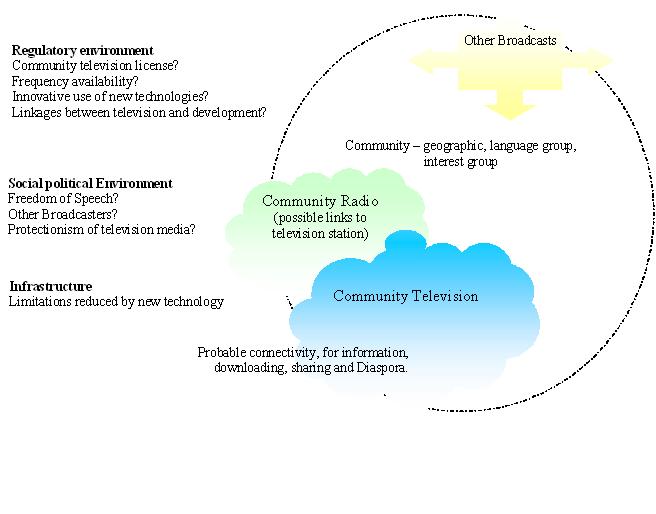|
This site present the results of a 14month research programme funded by the Department of International Development UK and led by Gamos Ltd
The Purpose of the research was to explore the opportunities presented by digital convergence for locally produced and broadcast integrated television & radio for development education, development communication strategies and local content capture among the poor.
The starting premises of the research were:-
Community radio is known to have strong developmental benefits +
There is a strong trend towards television, even among the poor +
There will be new opportunities for audiovisual media presented by digital convergence
These propositions together resulted in the question:
Will there be widespread deployment of such a thing as Community Television and if so, what might be its shape, what might be its essential features, and what role might it play in development?
The research was informed by desk research, two technical reviews and a stakeholder consultation in four countries – Honduras, South Africa, Tanzania and Ghana. It proved very timely as it contributed significantly to ongoing consultations in South Africa and Tanzania. In South Africa ICASA announced the availability of a four year community television license and ongoing lobbying for frequencies should result in a number of initiatives happening in the next year or so. In Tanzania, the regulator consulted on community radio licensing, resulting in a lowering in license fees.

The research confirms the starting premises. It confirms that community radio can be an agent of change. It uses data from household surveys to investigate the information needs of the Africa's rural poor, and confirms that the poor migrate to television. This migration is not so much due to wealth but depends more on the availability of electricity.
Regarding technical changes and digital convergence, the research outlines many different technological opportunities for broad and narrow casting – many of which are low power options which need not depend on infrastructure for either the broadcast or reception. It links many of these options to emerging digital technologies which by definition tend to be linked to wider connectivity.
However, although by implication from communities information needs there is effectively a significant and growing demand for local and community television there are a number of challenges to be overcome if community television is to become a common reality.
Regulation is often very restrictive for television broadcasts. This is based on analogue technologies and will need to be revisited by decision makers. The research suggests a number of changes that could be made that would ease the introduction of community television, but it also alerts regulators to the fact that the wide opportunities offered by the new technologies can in some cases open up ways of “sidestepping” current regulation.
The research also notes that community television for the poor is only likely to grow in an open social and political environment.
Human capacity is another challenge. No matter how easy to use technology may become, a community television station will depend on management skills, and open and transparent working environment, skills of creativity in applied programming, and an awareness of development issues.
Finally the research notes that although the broadcast technology has become very cheap, it is the running costs of stations that remains a significant challenge. Salaries, transport (for interviews) and overheads will demand regular income for the station no matter how low the technology becomes in price.

The net conclusion is that community television could play a huge role in empowering local communities. While community radio has such a role now, it is possible that television viewing could over the next ten years erode the role of radio. Uptake of low power televisions could leave communities with national or multi channel broadcasts that are entertaining but do very little to stimulate dialogue about development, empower people as agents of change, protect local language and local culture. Community television could play a strong role in stimulating development dialogue, supporting local economies, be a vehicle for decentralised government egovernance and share local content in local language and local culture – a local voice. Advocates of community television need to be realistic in the development of the institutional framework for the station, and in the influence of the wider environment on the shape of the station.
The report ends with a number of general recommendations, and a specific recommendation that some pilot community television stations should be set up in the immediate future to document the parameters required for a successful innovative community television station.
|